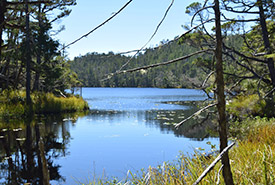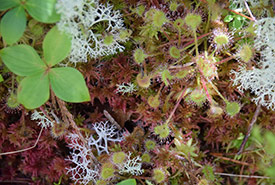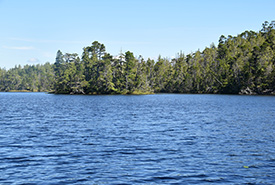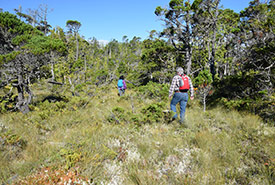Spider Island
Due to the elevated wildfire risk across British Columbia, some of NCC’s conservation areas are currently closed to public access. Please check our Current Fire Closures page for more information.

A magical day at Spider Island (Photo by NCC)
In 2016, the Nature Conservancy of Canada (NCC) acquired 47 hectares (98 acres) on Spider Island, on BC’s central coast. Encompassed by lands protected by the Hakai Lúxvbálís Conservancy, this acquisition resulted in a rare conservation success: the complete protection of a whole island. This property is the only private parcel on Spider Island, which is otherwise owned by BC Parks.
Located 34 kilometres south of Bella Bella, this remote property is covered in old-growth temperate rainforest. Gnarly, wind worn and stunted Alaska cedar, western red cedar and Sitka spruce — many more than 300 years old — cover the island, which also supports freshwater lakes, bog communities and kelp forests.

Sundew at Spider Island (Photo by NCC)
Open bog patches on the island allow sphagnum moss and round-leaved sundew to thrive. As a result, a pillow-like blanket of vegetation has formed on the forest floor. A large lake provides a watering and resting area for waterfowl, including sandhill cranes migrating along the Pacific flyway. Off the island’s rocky shores, kelp forests provide a significant feeding and breeding area for recovering populations of the provincially vulnerable sea otter.
In addition to its natural features and its importance as part of the traditional territory of the Heiltsuk Nation, Spider Island also carries with it a unique history as a former Second World War radar station.

Spider Lake (Photo by NCC)
Conservation and military history mingle on Spider Island
From another perspective, protecting Spider Island also offers the chance to remember a unique and little-known role that the West Coast played during the Second World War. Following the attack on Pearl Harbor, the Canadian government established a network of radar stations along the BC coast to provide an early warning system for attacks from the Pacific.
Spider Island once hosted a Royal Canadian Air Force station. Construction began in 1942, with crews carving space out of the untouched forest for the radar surveillance equipment, a camp site, operations building and powerhouse. The station became operational on June 11, 1943, and ran until it was disbanded on August 10, 1945.
At the height of its activity, the station supported 70 personnel who, despite the remote location, enjoyed two movies a week, volleyball and badminton tournaments, a station paper (The Spider Web) and visiting entertainment performances.

Exploring Spider Island (Photo by NCC)
The station suffered through the rough coastal conditions, with bad weather damaging roads and power lines. High winds frequently required the radar array to be locked down. In the face of this ruggedness, the station was kept clean and neat, even sporting painted hydrants, a flagpole, streetlights and gardens; all of which “made the station as livable as could be expected during wartime in the sticks,” notes the text on a plaque commemorating the station on the island.
Following the war, a detachment of four men remained on Spider Island to operate a radio signal that aided aircraft flying between California and Alaska. Advances in navigation and aircraft ranges eventually outstripped the need for this technology, and the Spider Island radar station was completely shut down.
Today the forest is reclaiming the space cleared for this 20th century military installation, erasing all traces of its history.




